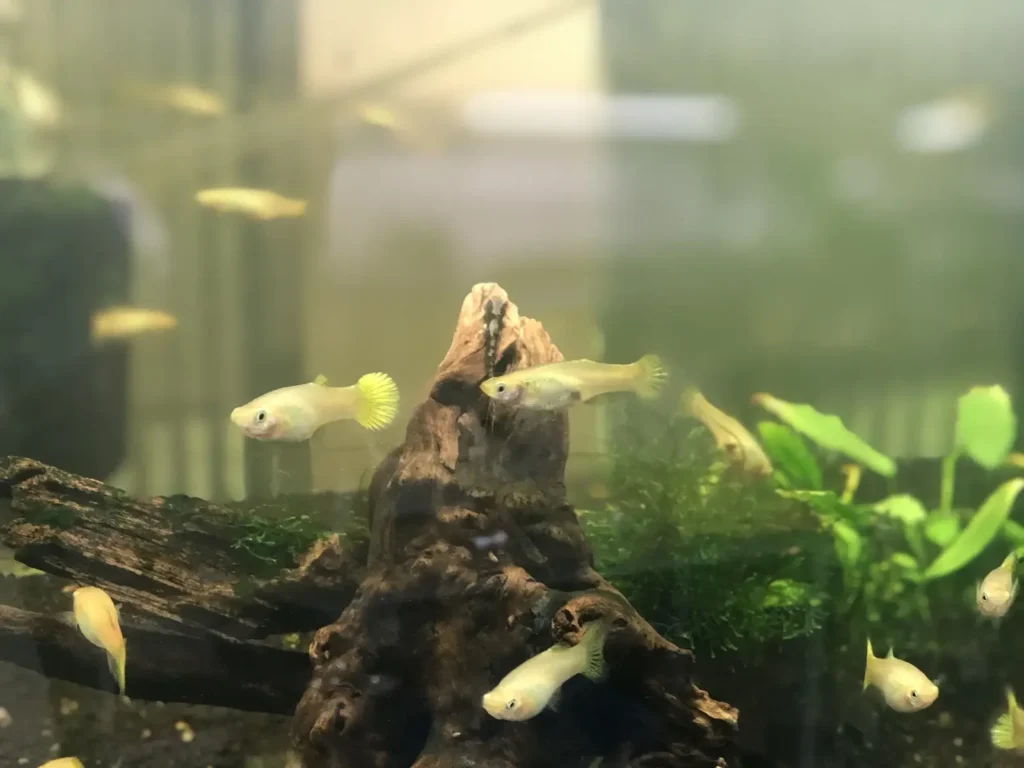
Platy fish have disappeared from the tank, and people who keep fish tanks get stinky. The Platy fish are on top of the list because they are the easiest to maintain, and they are loved for their beautiful colors, which makes them great for beginner and hobby aquarists. Thanks to the look, the car in the commercial loses its charm, and the buyers start to guess what the problem is with this model. So it’s about time to check the water and the health of fish feeding on it. It reveals that owing to this fact, maintaining a fish tank may seem like a complicated task.
Understanding Platy Fish
Learning platyfish is vital for the success of fishkeeping. The platyfish, a species widely known with the genus Xiphophorus, is a little hardy fish of the freshwater vegetation available in Central America. They occupy warm water, with a desired temperature range of 70 to 78 degrees Fahrenheit. The Platy fish are livebearers, delivering free-swimming fry instead of ovulating.
This reproductive trait makes them prolific breeders in home aquariums. They are available in different colors and patterns, making fish tanks livelier and more colorful. Obtaining high-quality water and a balanced diet are critical to safeguard the health of broilers. Water changes are recommended to be done regularly, whereas stress must be monitored closely. Also, offering a wide range of food can aid the fish in staying healthy and continuing to enjoy their lives.
Common Reasons for Platy Fish Disappearances From the Tank
Platy fish disappearing from the tank can be a surprise even for an experienced fish enthusiast.
Several factors could be at play:
- Predation: The bigger fish in the tank may consider the platyfish prey and attack them. Whether it is proper to have a community tank or not by researching and understanding the temperaments of all animals concerned.
- Disease and Stress: Platy fish is prone to multiple diseases, and stress can aggravate these diseases, resulting in the eventual death of the fish. Polluted water, suffocating crowds, and unhealthy diets are causes of anxiety and health problems.
- Jumping Out of the Tank: Platies may need to be kept in well-covered tanks because they may never get out of the water and end up outside the tank if the lid isn’t secured correctly. The low water conditions, poorness of the tank environment, or stress among the platyfish can be the factors that trigger the escape behavior of the platyfish.
- Hiding or Camouflaging: Sometimes, platyfish don’t turn into thin air but find perfect spots to hide among tank decorations. Additionally, they can excavate in the sand or aquatic vegetation and giddily hide among thickly grown plants when restricted or in a stressful situation.
- Water Conditions: Faster-growing platyfish are more susceptible to sudden drops in water temperature, pH levels, and chemical imbalances that can lead to their death, making them popular among those who take water conditions into account.
Steps to Address the Issue of Why Platy Fish Have Disappeared From The Tank
When Platy fish have disappeared from the tank, certain measures must be taken promptly and carefully as they shall help to establish the reason behind their disappearance and to prevent the same in the future.
Follow these steps to address the issue:
- Check for Escapes: Look at the environment around the fish tank to see if some have jumped out. Ensure the enclosure is well-covered, making it difficult for the animal to evade.
- Assess the Water Quality: Check for ammonia, nitrite, nitrate indicators, pH balance level, and temperature. Temperature fluctuation and other water conditions can be harmful, if not fatal, to the platyfish. Balance the water chemistry by considering suitable dissolution rates.
- Observe Tank Inhabitants: Watch the actions of other fish and invertebrates closely in the aquarium. Inter-demy aggressiveness or plain visible predatory attempts can portray that the balance is not right, possibly requiring narrowing to ascertain where they belong.
- Inspect for Illnesses: Look for the symptoms of diseases or stress among the other platyfish or other aquarium animals that are still alive and investigate if the situation persists. Segregate sick fish promptly to avoid fashioning another contaminated area.
- Enhance Tank Environment: Proper hiding spaces and sufficient space for all fish is essential. Fish stressed may bite that they share a tank. Decorations with plants or bushes can shelter bullied and stressed fish using the fish tank.
- Review Diet and Feeding Schedule: It is important to ensure that you are feeding a diet suitable for the platyfish, which is also balanced, thereby keeping the feeding frequency at a manageable level, which is not an over-fed diet.
- Implement Regular Maintenance: Set a schedule for changing water, filter cleaning, and condition checks to be sure the platyfish have a stable and fostering environment.
- Educate on Proper Stocking: It is important to do research and know their specific needs – water parameters, temperature, tank size, and other tank mates. Get stock levels and species’ compatibility rights; otherwise, they will be stressed and predicated.

How to Prevent Platies from Escaping the Aquarium
To keep Platy fish from jumping out and disappearing from the tank and getting hurt, you must close their tank securely without holes big enough for filters or wires. When the water is properly maintained at the correct temperature and pH level and clean, the fish feel less stressed and will not try to jump. When buying a fish tank, choose one that’s not oversized, place only a few fish of different species, and ensure they are grouped properly to avoid stress and jumping out of the tank. Put several plants, stones, and covert places so they do not want to jump out, and the platies fish will feel safe.
This is why giving them the right amount of feed to avoid water pollution and stress is equally important. Make a feeding schedule, have your fish watched carefully, and act on any sick ones quickly. For instance, if fish don’t enjoy living in water that is dirty or isn’t their natural habitat, they might try to escape, which would exacerbate their stress and sickness.
Recognizing Signs of Illness or Disease in Platy Fish
Early sickness diagnosis in platy is critical as this will help with prompt treatment and support their health. Something is wrong if you see dried-out spots, faded colors, any growth, cloudy eyes, torn fins, or dull colors. They could be sick if they swim weirdly, like they move wrong, bouncing up and down, spinning, scratching on really weird things, and floating weirdly.
If they stop snacking or eat smaller amounts, it could imply they are stressed or not feeling better. They could be unless they are always moving, remaining at the bottom level of the pool, or in their hideouts for a long time. Fish can suddenly wave their fins or rapidly chase each other because they breathe or the water is unhealthy. In addition, they may be sick if they do not want to see others, and they may also hide.
Setting Up an Ideal Tank Environment for Platy Fish
To keep platy fish healthy, ensure they have disappeared from the tank. You need a tank of at least 10 gallons as they like to swim. Use soft ground and a good filter to make it like their natural habitat and keep water clean and with the right amount of oxygen. Add real plants, rocks, and hiding places to reduce stress levels in fish and have cleaner water. Without the correct light, plants cannot grow and remain healthy.
Maintain the water temperature between 70°F and 78°F and the pH level from 7.0 to 8.2. Test the water for ammonia, nitrite, and nitrate, and change about 25% of the water every week to ensure water sanitation. They fill their tanks with good flakes, pellets, and sometimes live or frozen food to ensure they get what they want. Cleaning and maintaining your platy fish tank will ensure your fish thrive and feel good.
Conclusion
Platy fish have disappeared from the tank for different reasons, including jumping out of the aquarium, other fish eating it, falling sick or stressed, or dying. Still, people have not noticed due to the aquarium’s poor water quality and neglect. Watching after the fish, for example, cleaning the aquarium and ensuring they are happy and healthy, is a good start. If you take the time to make your tank a suitable place for platyfish, check their health, and satisfy their needs, they can be great tank inhabitants. A contented and healthy platy fish won’t try to run away from its tank or even get sick frequently. Caring for them is both responsible and interesting for any fish pet owner.
Frequently Asked Questions (FAQs)
1. Why did my platy fish jump out of the tank?
The Platy fish’s tendency to escape is often associated with stress, poor water quality, or overcrowding. Establishing a stable, safe environment with well-kept water parameters and a secure, closeable lid is the best way to avoid inherent instincts. Low-quality water or conditions inside the tank could cause animals to try to escape.
2. How can I tell if my platyfish is stressed or sick?
Signs of ill or stressed platyfish include unusual swimming, lack of appetite, blurred colors, and changes such as cloudy eyes or spots. Bearing in mind that your fish should be looked at every day, you will spot the symptoms early and be able to address any problems immediately.
3. What should I do if I can’t find my platyfish in the tank?
If your platy is missing, investigate the hiding spots within the tank and in the filter compartment before checking the aquarium for escapees. Moving on, assess the tank’s conditions, including the other neighboring species’ behaviors, to check if stress, predation, or disease could be the real cause.
4. How can I prevent my platy fish from disappearing?
To avoid losing your platyfish, check and maintain the proper water conditions regularly, feed them a balanced diet, create a calm environment with enough hiding places, and ensure the tank is closed. Additionally, close attention to your fish’s health and regular behavior is vital to catching any problems early on.
Also Must Read: Is Fish Tank Water Good for Plants?



